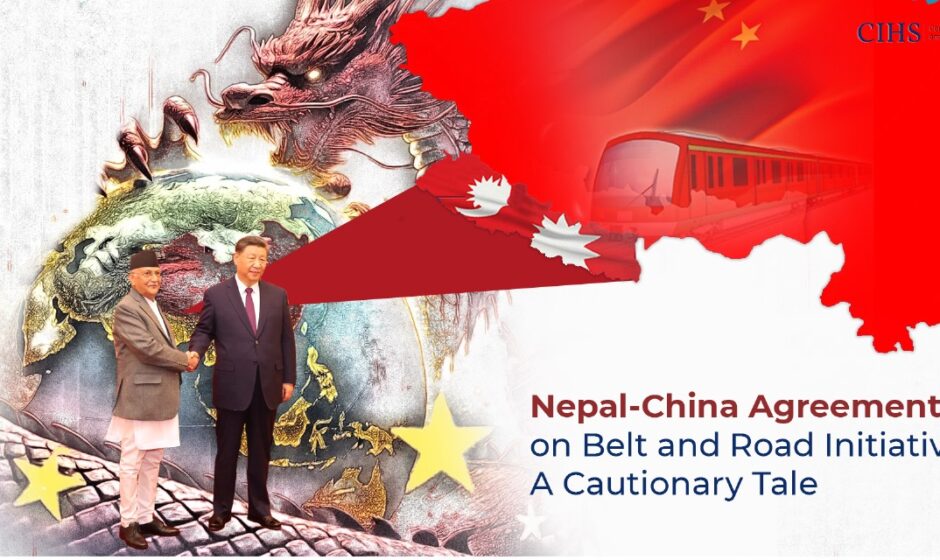Nepal stares at huge economic costs built into BRI while President Xi pursues his expansionist geo-political interests in South Asia.
Rohan Giri
Earlier this month, Nepal’s communist regime sealed a deal with China to join ill-famed Belt and Road Initiative (BRI) that pushed several least developed and developing countries into the dragon debt trap.

The dragon pact marks a key policy shift for Nepal moving it away from its millennial ally Bharat with civilizational links and signifies : closer alignment with Beijing.
While the deal promises economic benefits especially through infrastructure development, it raises significant concerns about Nepal’s sovereignty, financial stability and regional security. More than a bilateral development project, BRI threatens to exacerbate Nepal’s internal challenges and entangle it in China’s geopolitical web.
A Faustian Bargain
Chinese President Xi Jingping’s signature project, Belt and Road Initiative, has been pushed aggressively as passage to economic growth for the developing nations where much-needed infrastructure would be in place, thereby enhancing trade connectivity and promoting economic growth.
For Nepal, being a landlocked country on brink of economic revival, BRI seemed like just the ticket to lift isolation. Beneath the purported economic attraction lies a much darker reality — one of financial vulnerability, political dependency, and loss of sovereignty.
The deal, while touted as a historic step by ruling Communist government, is nothing short of a Faustian bargain for Nepal. Prime Minister KP Sharma Oli deciding to go to China as his destination for the first foreign trip after assuming office and subsequently endorsing the BRI, marks a dramatic shift in Nepal’s foreign relations, which were traditionally close cultural and economic ties with India.
But, with rising proximity to China — and its growing political and economic influence — comes an entirely new set of dangers that could be disastrous for Nepal.
China’s Economic Mirage
Behind the BRI lies a worrying financial model which has already ensnared several countries in crippling debt. BRI is mostly financed through huge loans from China usually on terms that put developing countries at risk of default.
The countries that embraced the BRI such as Sri Lanka and Pakistan have been saddled with unsustainable debts. A case in point is how Sri Lanka was forced to lease Hambantota Port to a Chinese firm for 99 years following its failure to service the loans.
Apprehension about Nepal getting into the vicious debt trap is very valid for this reason alone. Nepal, with a miniscule industrial base, having chronic fiscal deficit and depends on foreign aid, makes this over-leveraging risk extremely high.
For one, BRI-sponsored Pokhara International Airport has already faced operational setbacks due to dearth of international flights that now faces the added headache of India’s airspace ban. The economic rationale for Nepal to continue pursuing Chinese loans is increasingly unclear especially when one considers the broader regional dynamics and Nepal’s precarious economic wherewithal.
Communist Regime’s Illusory Promises
The appeal of BRI to Nepal Communist government cannot be underestimated. Indeed, the ruling regime led by Nepal Communist Party (NCP) placed itself precariously between Chinese-style state-driven development and Nepal’s ambitions to evolve as a modern buzzing economy.
Historic record of Communist regimes relying on foreign loans for ambitious infrastructure projects is far from encouraging. In countries like Sri Lanka and Venezuela, alignment with Chinese-funded initiatives has led not only to financial instability but also to political entanglements with Beijing, eroding the sovereignty of these nations. Nepal, too, risks losing control over its internal affairs if BRI’s promises fail to deliver as has happened in other nations under Chinese influence.
The promises of job creation, improvements in infrastructure and growing economy from Communist regime would end up being hollow ones as this would lead to greater social inequality, political unrest and growing dependence on China.
This could also manifest in a variety of ways: from suppression of political dissent in favour of Chinese interests to siphoning off of Nepal’s resources to meet Chinese repayment schedules. The people of Nepal already burdened by poverty may feel further alienated given their own government prioritizing Chinese loans.
Strategic Dilemma and Geopolitical Tension
Nepal’s entry into BRI, though framed as a development initiative, has far-reaching geopolitical implications as well. Nepal’s location, nestled between India and China has long made it a strategic focal point in South Asia. India with which Nepal shares not just a long border but also cultural, economic, and historical ties, has expressed some very strong reservations about BRI.
China’s larger strategy to expand geo-politically via BRI has been well documented that throws up fresh security challenges in South Asia.
India has reasons to worry about China’s activities. For instance, China-Pakistan Economic Corridor (CPEC) of BRI which passes through an illegally occupied region of Jammu and Kashmir is an example of how China’s infrastructure development works in tandem with its military strategic interests. To New Delhi, Nepal’s inroads with China is alarming for it will change the region’s delicate balance of power.
The danger of alignment between Nepal with China is bound to provoke India given Kathmandu and New Delhi’s hitherto long-term relations. The risk is also that Nepal gets entangled in a wider strategic competition between China and India in which it has no particular leverage to speak of.
A small yet significant nation becoming more and more dependent on China might lead to reduction in its own foreign policy independence as Nepal is increasingly drawn to align itself with wider strategic priorities of Beijing.
Subtle Erosion of Sovereignty
China’s influence in Nepal is not confined to economic aspects. While BRI may be portrayed as an innocuous development initiative, it also provides a tool for subtle control over political affairs. It is seen that China gets leverage on Kathmandu through finance of large-scale infrastructure projects as well as loan offers, not only from economic perspective but through political sway. This trend is witnessed in Sri Lanka and other countries under BRI, where dependency on debt leads to gradual loss of sovereignty.
Thus, eagerness of Nepali Communist government to align with China under the BRI framework is fraught with risks. While Chinese investments may provide a temporary boost to economy, it could also enable Beijing to exert deeper control over Nepal’s political landscape. From setting the terms of loans to influencing domestic policies, China’s growing presence in Nepal will likely result in weakening of Nepal’s political independence.
BRI costs are too huge
Nepal’s pursuit of BRI under leadership of its Communist government threatens to throw up fresh issues than those that get resolved. Promises of economic development and infrastructure modernization are tempting but come with a hidden cost: unsustainable debt, increased political dependency on China and growing friction with India. Nepal, a country steeped in history for sovereignty and independence, risks becoming caught in a geopolitical trap, unable to chart its own course.
For Nepali people, signing of BRI framework agreement may bring an era of economic stagnation, social inequality and political subjugation. BRI will not be a sustainable solution for Nepal’s economic woes but rather a catalyst for deeper challenges. As Nepal moves closer to China, embracing Beijing’s development model may lead to erosion of both nation’s sovereignty and welfare of her citizens.
Nepal’s pursuit of BRI would turn out to be a story more cautionary than promotional for other countries seduced by China’s vision and promise.
(Author is a doctoral fellow at Amity University in Gwalior, content manager at Centre for Integrated and Holistic Studies, New Delhi)



